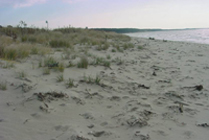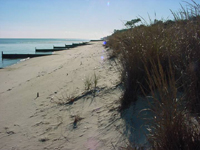What Are Dunes?
Introduction

Dune systems of the Commonwealth of Virginia are a unique and valuable natural resource. The primary dune and beach of existing shore systems are protected under the Coastal Primary Sand Dunes and Beaches Protection Act (the Act). Until 1998, the exact extent of existing dune systems in the Chesapeake Bay was largely unknown. In addition, the relationship between primary and secondary dunes had not been explored.
The Virginia Coastal Zone Management Program initiated a study with VIMS' Shoreline Studies Program to locate, classify, and enumerate the existing jurisdictional dunes and dune fields within the eight localities listed in the Act. These include the counties of Accomack, Lancaster, Mathews, Northampton, and Northumberland and the cities of Hampton, Norfolk, and Virginia Beach. Only Chesapeake Bay and river sites are considered. To provide a basis for sound resource management and consistency within dune management programs, this project set forth to:
- determine the extent of the existing dune systems around Chesapeake Bay,
- determine morphologic changes of selected dune systems and the factors that influence their evolution,
- develop a geology-based classification of dune system types using influencing factors, and
- determine the relationship between primary and secondary dunes.
Background
Coastal primary sand dunes form by the accumulation of sand due to the interaction of wind and wave action along the shore. Sand deposited on the beach during periods of relatively low wave energy is moved landward by onshore winds. The deposition of material above the intertidal zone allows vegetation to take root along the wrack line which then acts as a baffle, slowing wind speed and causing wind-borne sand to settle and be trapped in the vegetation, thereby resulting in further accretion of the dune. Therefore, the size and location of a primary dune is determined by the amount of sand available and the ability of wind and waves to move it as well as the degree to which any existing vegetation can act to trap it. Just as the intensity, direction, and duration of winds and waves constantly change through the seasons, so too, do coastal dunes. They exist in a state of flux.
Dunes act as a reservoir of sand which can buffer inland areas from the effects of storm waves and, in the process, act as natural levees against coastal flooding. During high energy conditions, such as the northeast storms which frequent the Eastern Seaboard, primary dunes may be subject to attack by wind-driven waves aided by storm surges. The dune may be eroded, and the sand deposited in an offshore bar. Then, under low-energy conditions, the sand may move back to the beach.
All dunes in the Chesapeake Bay estuarine system are mobile features especially with regards to coastal zone management. Unlike ocean dune fields that are relatively continuous features exposed to the open ocean, the dunes of the Chesapeake form across a temporal and spatial geomorphic matrix driven by sand volume, varying wave climate, and shoreline geology. The coastal geology, in large part, determines whether shoreline erosion acts upon the upland (high bank) or marsh (low bank). Sand supply and the long-term local wave climate are significant factors in the location of dunes. The stability or ability of a dune/beach system to accrete over time is necessary for the formation of secondary dunes.
Natural dunes in the Chesapeake Bay estuarine system vary in size and nature, but all require an accreted feature, such as a beach washover or a spit to become vegetated above the intertidal zone. Vegetation and a continuous beach/dune profile are required to create the jurisdictional primary dune. When the dune/beach forms across a low marsh shoreline, the system may move landward in response to storms, and only a low primary dune will exist. If sand can accrete bayward due to shoals, spits, or man-made features such as jetties and groins, then a secondary dune may develop from the original primary dune.

